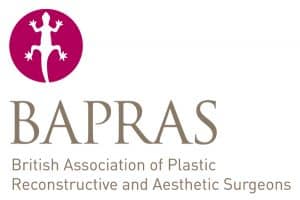
Breast Procedures
Inverted Nipple Correction
25 Upper Wimpole Street
London W1G 6NF
Inverted Nipple Correction
An inverted nipple (occasionally “invaginated nipple”) is a condition where the nipple, instead of pointing outward, is retracted into the breast. Around 10–20% of all women are born with this condition. Most common nipple variations that women are born with are caused by short milk ducts or a wide areola muscle sphincter.
There are three grades of inverted nipples, defined on how easily the nipple may be protracted and the degree of fibrosis existent in the breast as well as the damage it has caused on the milk ducts.
Grade 1:
The nipple is easily pulled out manually and maintains its projection quite well. Grade 1 nipples are believed to have minimal fibrosis. Also, Grade 1 inverted nipples may occasionally pop up without manipulation or pressure. Milk ducts are usually not compromised and breastfeeding is possible.
Grade 2:
The majority of inverted nipples belong to grade 2, i.e., the nipples can be pulled out but cannot maintain projection and tend to go back again (that is: nipples retract back after the pressure on the areola has been released). Breastfeeding could be possible even though it is more likely to be very difficult. These nipples are thought to have moderate fibrosis beneath the nipple.
Grade 3:
Inverted nipple Grade 3 describes a severely inverted and retracted nipple which can rarely be pulled out physically and which requires surgery in order to be protracted. Milk ducts are often constricted and breastfeeding is impossible. Women with Grade 3 inverted nipples may also struggle with infections, rashes, or problems with nipple hygiene. The fibrosis is remarkable and lactiferous ducts are short and severely retracted. The bulk of soft tissue is markedly insufficient in the nipple. In grade 3, to which the least number of inverted-nipple cases belong, the nipple can hardly be pulled out manually.
Inverted nipple surgery is a quick and simple procedure which usually takes approximately 30 minutes per nipple and can be performed under local anaesthetic, allowing the patient to go home on the same day.
A small incision (6 mm in length) is made in the lower outer margin of the nipple. Depending on the grade of inversion, the milk ducts leading to the nipple are then either gently stretched or divided.
Once released, the nipple is maintained in an inverted position with a dis-solvable stitch.
If the ducts are stretched they remain intact and breastfeeding is usually possible after the procedure.
In most cases though, the milk ducts will have to be divided, which leads to inability to breastfeed.
The recovery is extremely comfortable with virtually no down-time and dressings are removed 7 days after surgery.
To book a consultation call 07943 277 215 or email clinic@lindafiumara.com
Breast Procedures
Inverted Nipple Correction
Inverted Nipple Correction
An inverted nipple (occasionally “invaginated nipple”) is a condition where the nipple, instead of pointing outward, is retracted into the breast. Around 10–20% of all women are born with this condition. Most common nipple variations that women are born with are caused by short milk ducts or a wide areola muscle sphincter.
There are three grades of inverted nipples, defined on how easily the nipple may be protracted and the degree of fibrosis existent in the breast as well as the damage it has caused on the milk ducts.
Grade 1:
The nipple is easily pulled out manually and maintains its projection quite well. Grade 1 nipples are believed to have minimal fibrosis. Also, Grade 1 inverted nipples may occasionally pop up without manipulation or pressure. Milk ducts are usually not compromised and breastfeeding is possible.
Grade 2:
The majority of inverted nipples belong to grade 2, i.e., the nipples can be pulled out but cannot maintain projection and tend to go back again (that is: nipples retract back after the pressure on the areola has been released). Breastfeeding could be possible even though it is more likely to be very difficult. These nipples are thought to have moderate fibrosis beneath the nipple.
Grade 3:
Inverted nipple Grade 3 describes a severely inverted and retracted nipple which can rarely be pulled out physically and which requires surgery in order to be protracted. Milk ducts are often constricted and breastfeeding is impossible. Women with Grade 3 inverted nipples may also struggle with infections, rashes, or problems with nipple hygiene. The fibrosis is remarkable and lactiferous ducts are short and severely retracted. The bulk of soft tissue is markedly insufficient in the nipple. In grade 3, to which the least number of inverted-nipple cases belong, the nipple can hardly be pulled out manually.
Inverted nipple surgery is a quick and simple procedure which usually takes approximately 30 minutes per nipple and can be performed under local anaesthetic, allowing the patient to go home on the same day.
A small incision (6 mm in length) is made in the lower outer margin of the nipple. Depending on the grade of inversion, the milk ducts leading to the nipple are then either gently stretched or divided.
Once released, the nipple is maintained in an inverted position with a dis-solvable stitch.
If the ducts are stretched they remain intact and breastfeeding is usually possible after the procedure.
In most cases though, the milk ducts will have to be divided, which leads to inability to breastfeed.
The recovery is extremely comfortable with virtually no down-time and dressings are removed 7 days after surgery.








Copyright © 2025 Dr Linda Fiumara MD
Website by Createch



